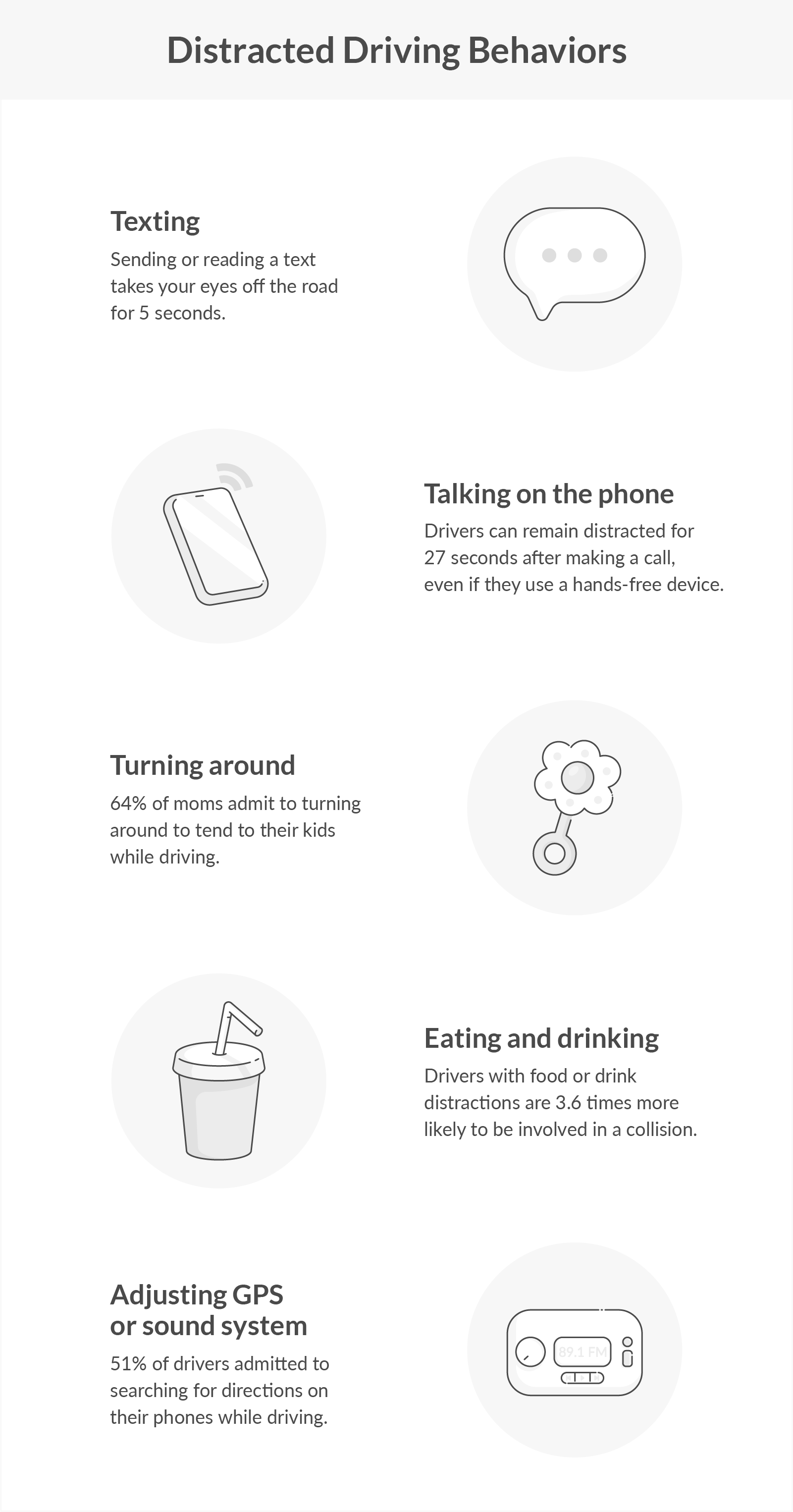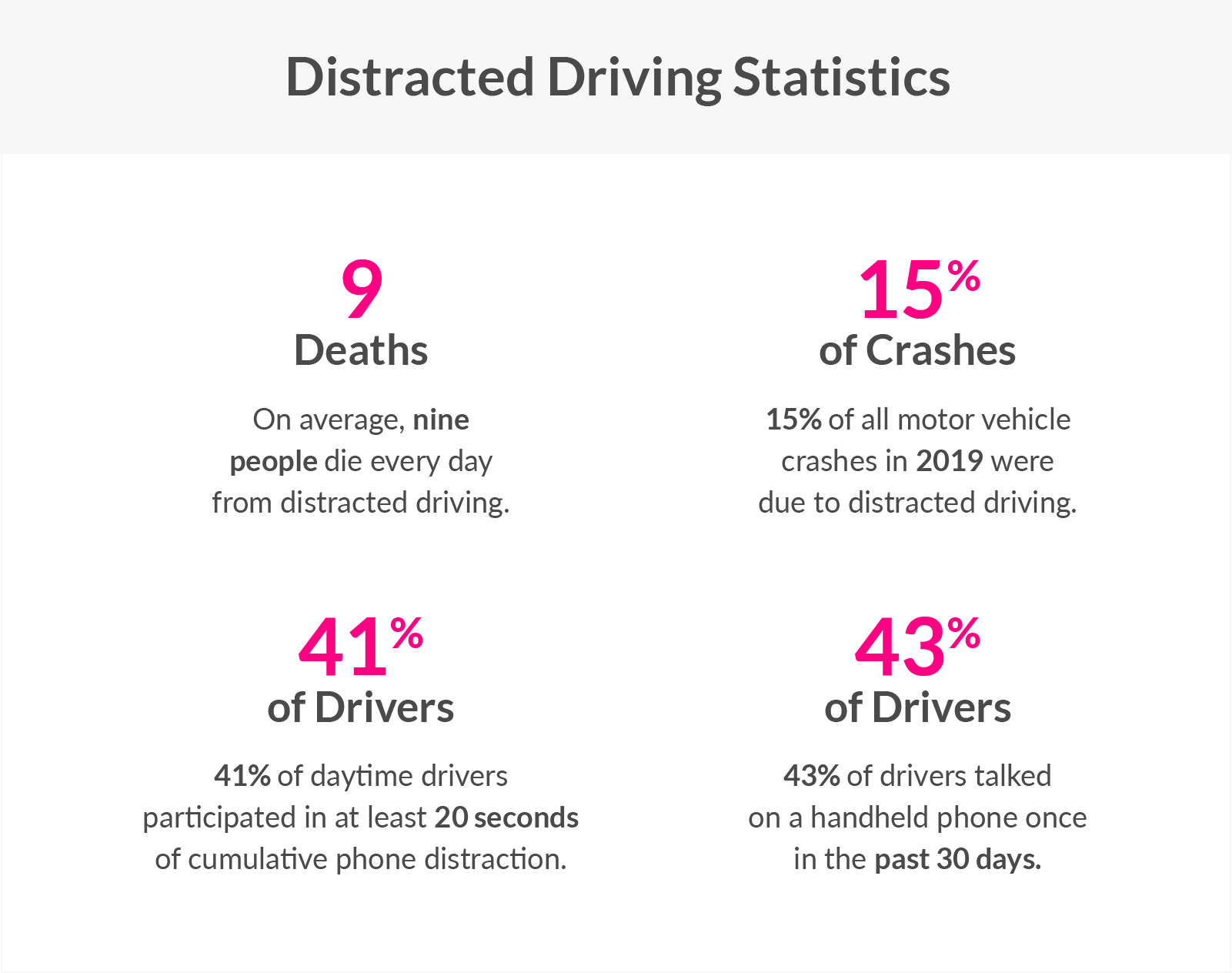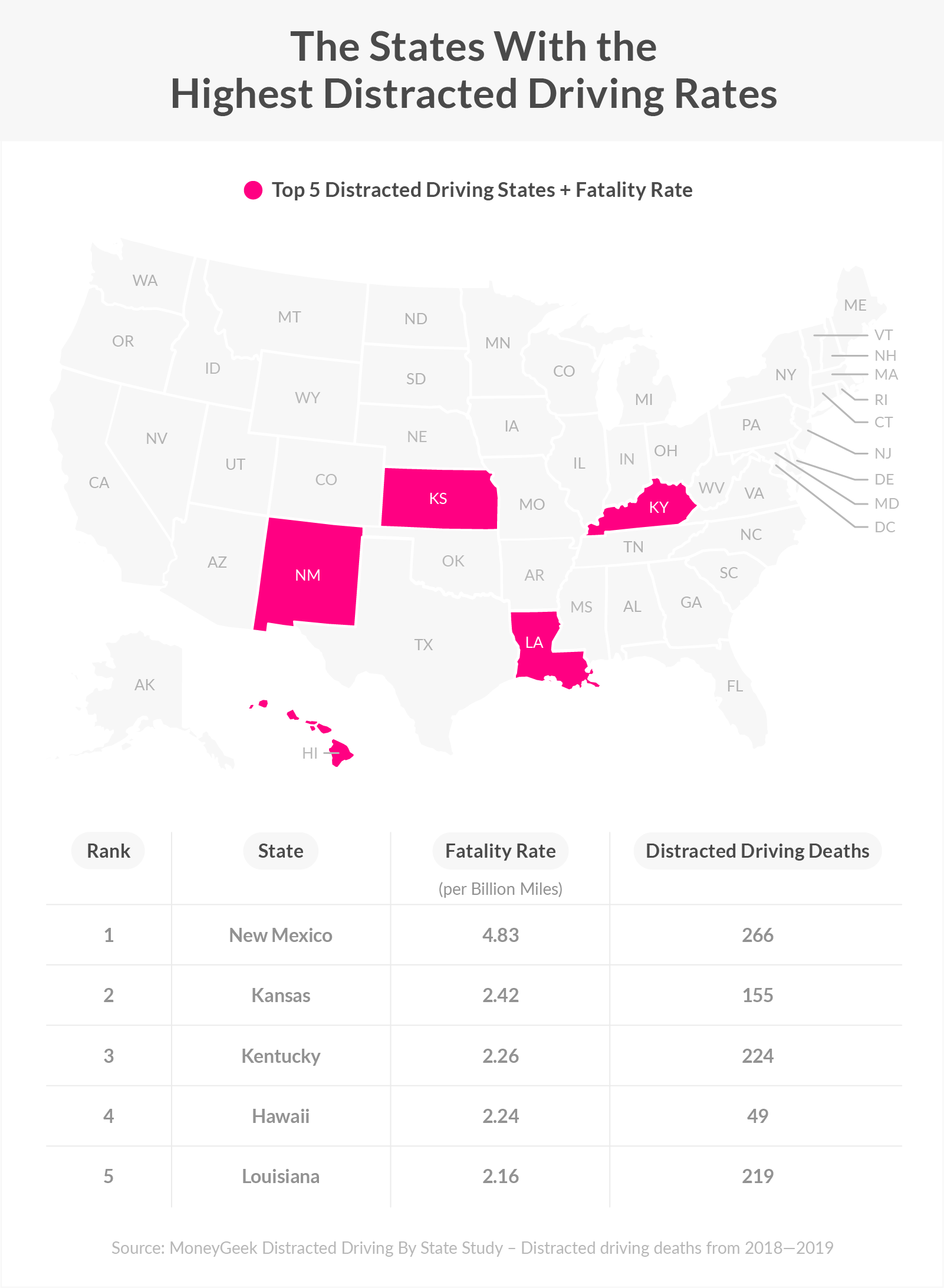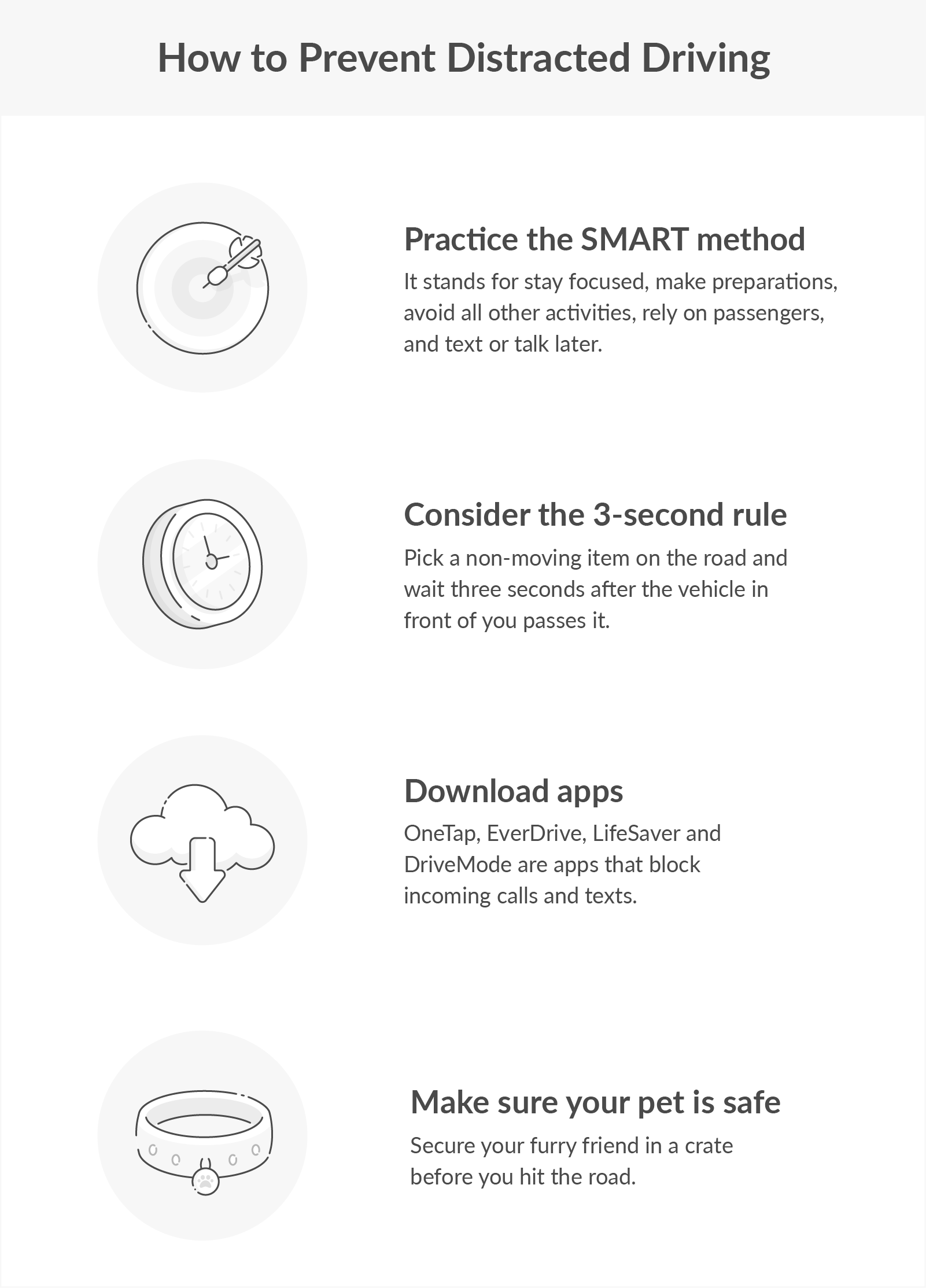Distracted Driving Statistics In 2022 And Why They Matter
Keeping your eyes on the road will protect you in the long run.

Keeping your eyes on the road will protect you in the long run.

80% of car collisions involve some form of distraction that occurred three seconds before the crash.¹
You invest in auto insurance to protect your vehicle, yet as soon as your eyes leave the road, you could be faced with a potentially fatal situation.
To help you better understand the danger of distracted driving, we’ve compiled a list of distracted driving statistics from the National Highway Traffic Safety Administration, Insurance Information Institute, and more.
We also provide tips on how to avoid getting distracted behind the wheel to help you stay safe on your next outing.
The National Highway Traffic Safety Administration (NHTSA) defines distracted driving as any activity that could divert attention from the primary task of driving.
That’s pretty broad. A few obvious examples of distracted driving include texting, eating or drinking, and messing with the radio; however listening to music at a loud volume or using a hands-free phone still fall under the umbrella of distracted driving, if doing so diverts your attention.
In fact, the National Safety Council, says that “hands-free is not risk-free,” as studies show that mental distractions can still dangerously undermine a driver’s attention.
There are several types of distracted driving, including visual and auditory distractions.
Below we cover the different types of distracted driving as well as common behaviors that have resulted in fatal accidents.
Visual distractions
Visual distractions include turning your head to talk to a passenger or watching the scene of an accident as you’re driving by (aka rubbernecking). Visual distractions tend to happen most when passengers or children are present. According to a study from American Baby, 64% of moms admit to turning around to tend to their kids while driving.
Auditory distractions
Even though we live in a digital age with Bluetooth-compatible technology in our cars, auditory distractions like talking on the phone are still very distracting. In fact, talking on the phone while behind the wheel increases the risk of injuries and death. Drivers can remain distracted for 27 seconds after making a call, even if they use a hands-free device, according to the American Automobile Association Foundation for Traffic Safety.
Manual distractions
Manual distractions include eating or drinking, texting, or using any sort of electronic. Texting and driving accounts for thousands of accidents per year. Sending or reading a text takes your eyes off the road for 5 seconds; according to the NHTSA, at 55 mph, that’s like driving the length of an entire football field with your eyes closed.
Cognitive distractions
A prime example of a cognitive distractions is when you’re too tired to focus on the road or you’re consumed with strong emotions. In 2019, the NHTSA reported that there were 697 fatalities in motor vehicle crashes that involved drowsy drivers, and drowsy driving fatalities were 1.9 percent of total driving fatalities.

Drivers are engaging in distracted behaviors on a constant basis. Let’s paint a picture with a few stats and insights.

Distracted driving is not a problem that arose in the 21st century. In fact, even though technology in cars is evolving year after year, people are still getting dangerously distracted. It makes sense—driving long distances can get stressful, or boring, or tiring—but keeping your focus on the road is what keeps you alive.
Here are some statistics on how distracted driving trends have changed over the years.
What hasn’t the pandemic changed? Driving behaviors have fluctuated and evolved over the past two years. A mixture of job losses and telecommuting has led to a drop in road travel.
However, distracted driving rates have actually increased during the pandemic.
According to the GHSA, the surge of risky driving during the pandemic is likely caused by speeding, driving under the influence, and distractions.¹¹ The GHSA also claims the pandemic has increased the number of pedestrian deaths by 21% due to there being more travelers by foot.¹¹
Empty roads during the pandemic have allowed folks to drive faster than usual. Anxiety levels and increased drinking habits have also inflated distracted driving behaviors.
Here are a few more sobering stats:

Distracted driving statistics show a prevalent problem across the country. Here are a few distracted driving statistics, by state.
Let’s take a look at which states are the prime distracting driving offenders:
| Rank/State | Distracted Driving Fatality Rate (per Billion Miles) | Distracted Driving Deaths 2018-19 | Rank/State | Distracted Driving Fatality Rate (per Billion Miles) | Distracted Driving Deaths 2018-19 |
|---|---|---|---|---|---|
| 1. New Mexico | 4.83 | 266 | 27. North Carolina | 0.65 | 158 |
| 2. Kansas | 2.42 | 155 | 28. Michigan | 0.65 | 132 |
| 3. Kentucky | 2.26 | 224 | 29. Maryland | 0.64 | 77 |
| 4. Hawaii | 2.24 | 49 | 30. Pennsylvania | 0.62 | 128 |
| 5. Louisiana | 2.16 | 219 | 31. Wisconsin | 0.60 | 80 |
| 6. Washington | 1.75 | 219 | 32. Iowa | 0.58 | 39 |
| 7. Idaho | 1.48 | 53 | 33. New Hampshire | 0.58 | 16 |
| 8. New Jersey | 1.41 | 219 | 34. West Virginia | 0.55 | 21 |
| 9. Virginia | 1.29 | 221 | 35. Nebraska | 0.54 | 23 |
| 10. Texas | 1.18 | 675 | 36. Maine | 0.51 | 15 |
| 11. Arizona | 1.14 | 155 | 37. Ohio | 0.48 | 110 |
| 12. Oklahoma | 1.13 | 102 | 38. Minnesota | 0.47 | 57 |
| 13. South Carolina | 1.08 | 124 | 39. Massachusetts | 0.46 | 61 |
| 14. Florida | 1.01 | 452 | 40. Arkansas | 0.45 | 33 |
| 15. Illinois | 0.89 | 134 | 41. Utah | 0.42 | 27 |
| 16. Missouri | 0.86 | 134 | 42. Vermont | 0.41 | 6 |
| 17. New York | 0.82 | 203 | 43. South Dakota | 0.41 | 8 |
| 18. Colorado | 0.81 | 88 | 44. District of Columbia | 0.40 | 3 |
| 19. Alaska | 0.79 | 9 | 45. Georgia | 0.39 | 102 |
| 20. Montana | 0.78 | 9 | 46. Indiana | 0.38 | 63 |
| 21. Deleware | 0.73 | 15 | 47. California | 0.35 | 242 |
| 22. North Dakota | 0.71 | 14 | 48. Nevada | 0.33 | 19 |
| 23. Tennessee | 0.69 | 113 | 49. Connecticut | 0.28 | 18 |
| 24. Alabama | 0.68 | 97 | 50. Mississippi | 0.26 | 21 |
| 25. Wyoming | 0.68 | 97 | 51. Rhode Island | 0.06 | 1 |
| 26. Oregon | 0.67 | 49 |
Distracted driving comes with a lot of risk, including loss of life. Let’s break down some of the most recent distracted driving fatality statistics (buckle up, this one isn’t fun).
Since distracted driving is such a huge problem, you might think there are dozens of laws prohibiting dangerous behavior behind the wheel. But despite this being a pressing public safety issue, there aren’t so many distracted driving laws in place.
State, federal, and even local lawmakers continue to examine distracted driving issues, and have found cell phones and other electronic devices to be the most concerning distraction.
Let’s pump the brakes and cruise through some of the federal and state distracted driving laws.
Traffic laws are the responsibility of state governments, not the federal government.
However, since 2009, there is a federal law that prohibits federal workers from texting and driving while using a government business vehicle, or while using government equipment and operating a motor vehicle.
There is also a federal distracted driving law from the FMCSA that prohibits commercial motor vehicle drivers from making a call or pressing more than one button on a mobile device. However, commercial drivers are allowed to use a hands-free phone.
Throughout the country, there are state distracted driving laws in place surrounding handheld cell phone use.
Montana is the only state that does not ban texting while driving, while Missouri has a statewide ban on texting while driving for drivers under the age of 21.
Almost half of the states have laws in place that prohibit all handheld cell phone use for folks behind the wheel.
Here are the 24 states that ban handheld cell phone use: Arizona, California, Connecticut, Washington D.C. (not technically a state, we know), Delaware, Florida, Georgia, Hawaii, Idaho, Illinois, Maine, Maryland, Massachusetts, Minnesota, Nevada, New Hampshire, New Jersey, New York, Oregon, Rhode Island, Tennessee, Vermont, Washington, West Virginia.
If you’re the type of driver who gives in to distractions, you’re more likely to get in an accident. These drivers have a higher chance of causing serious injuries or even death.
So what happens if you engage in these behaviors?
There are criminal consequences of distracted driving. If a driver is caught using their phone while behind the wheel, they can face some major fines. Alaska and Utah have first-offense fines of over $700, and California and New York have fines of over $100.
A few other consequences of distracted driving include higher insurance rates and revoked driving privileges. Individuals with traffic citations and accumulated points on their driving records might experience raised insurance premiums. Drivers with too many points on their record can face their license getting suspended or revoked.

While the distracted driving statistics above might be eye-opening, the following tips are here to make sure you don’t become a statistic yourself. Here are some preventive ideas to reduce distractions when you’re behind the wheel.
The first rule of thumb when driving is to make sure you and all passengers buckle their seatbelts. Check to see your children, pets, and passengers are properly secure for their safety and to prevent distracted driving (that way mom or dad won’t have to turn around to make sure a 6-year-old is properly buckled).
When behind the wheel, put your phone away. And remember: Talking on the phone hands-free with Bluetooth technology is just as much of a safety risk. In fact, phone usage can impact your safety score with insurers like Lemonade. And major car manufacturers like Lexus and Tesla now have apps that track your speed, cornering, braking, and even your phone usage, and provide a rating.
‘The more the merrier’ isn’t the case when it comes to the number of passengers in your car. According to the AAA Foundation, teens between the ages of 16 and 17 double the risk of distracted driving when they carry more than two passengers in their car.
Every time you reach for food, drink, or a cigarette, your focus shifts. While a snack or quick sip during a lengthy road trip is okay in certain situations, indulging in a burger or venti hot coffee is not the best thing to do when you’re in the hot seat. However, using a straw can help reduce fidgeting with lids or worrying about spills. Make sure your items are easy to grab before you drive off, or pull over if you spill something.
In many contexts, the ability to multitask is a benefit. But when driving: Cut it out! Operating a moving vehicle involves a lot of focus and skill. When you start adding in other tasks while driving, your mind becomes distracted. Try to stick to the task at hand, which is simple: Drive from point A to point B safely.
Before you begin your next adventure, make sure you input your GPS settings. Futzing with Waze or Google Maps while moving is a recipe for disaster.
The most important distracted driving prevention tip is to focus on the road and nothing else. Texting, reading, and applying make-up are all distracting tasks you shouldn’t do while behind the wheel. Yeah, we get it—you’re in a rush. But that’s no excuse for risking your life.
Practice the SMART method to stay safe, which stands for stay focused, make preparations, avoid all other activities, rely on passengers, and text or talk later. Letting your mind wander can lead to crashes. Keep your eyes on the prize if you want to arrive at your destination in one piece.
Distracted driving affects insurance by raising a driver’s car insurance premium. Individuals who frequently get into accidents can expect to pay more for their car insurance.
Your driving habits can heavily influence car insurance rates with location-based technology. Lemonade uses telematics to reward you for safe driving while avoiding penalties based on demographics. The better you drive, the less you will pay for car insurance.
Just think how good it will feel to lower your car insurance premiums because of your safe driving. Check out our insurance rates today to see if you qualify for reduced rates.

Resources:
¹NHTSA & VTTI – Transportation Institute Releases Findings on Driver Behavior and Crash Factors
²NSC – Distracted Parents – Survey Results
³AAA – 2019 Traffic Safety Culture Index
⁴Accident Analysis & Prevention
⁵NHTSA – Distracted Driving 2019
⁶CMT
⁷NHTSA – Overview of Motor Vehicle Crashes in 2019
⁸IIHS
⁹NHTSA – Driver Electronic Device Use in 2018
¹⁰III – Archived Tables
¹¹GHSA – Pedestrian Traffic Fatalities by State: 2020 Preliminary Data
¹³AAA – New American Driving Survey
¹⁴NSC – Preliminary Semiannual Estimates
¹⁵FLHSMV
¹⁶MNDPS
¹⁷COTS
¹⁸DOISC
¹⁹OG
²⁰ZDM
²¹GTSC
²²AZDPS
²³NDOT
²⁴WTSC
²⁵WDOT
²⁶CDC
²⁷NHTSA – Early Estimate of Motor Vehicle Traffic Fatalities for the First Half (Jan–Jun) of 2020
²⁸III – Facts + Statistics: Distracted Driving
²⁹NHTSA – NHTSA Releases 2019 Crash Fatality Data
³⁰GHSA – Teens and Speeding: Breaking the Deadly Cycle
³¹KYFB – Distracted Driving Has Been Around Longer Than You Think
³²NHTSA – Driver Assistance Technologies
Please note: Lemonade articles and other editorial content are meant for educational purposes only, and should not be relied upon instead of professional legal, insurance or financial advice. The content of these educational articles does not alter the terms, conditions, exclusions, or limitations of policies issued by Lemonade, which differ according to your state of residence. While we regularly review previously published content to ensure it is accurate and up-to-date, there may be instances in which legal conditions or policy details have changed since publication. Any hypothetical examples used in Lemonade editorial content are purely expositional. Hypothetical examples do not alter or bind Lemonade to any application of your insurance policy to the particular facts and circumstances of any actual claim.